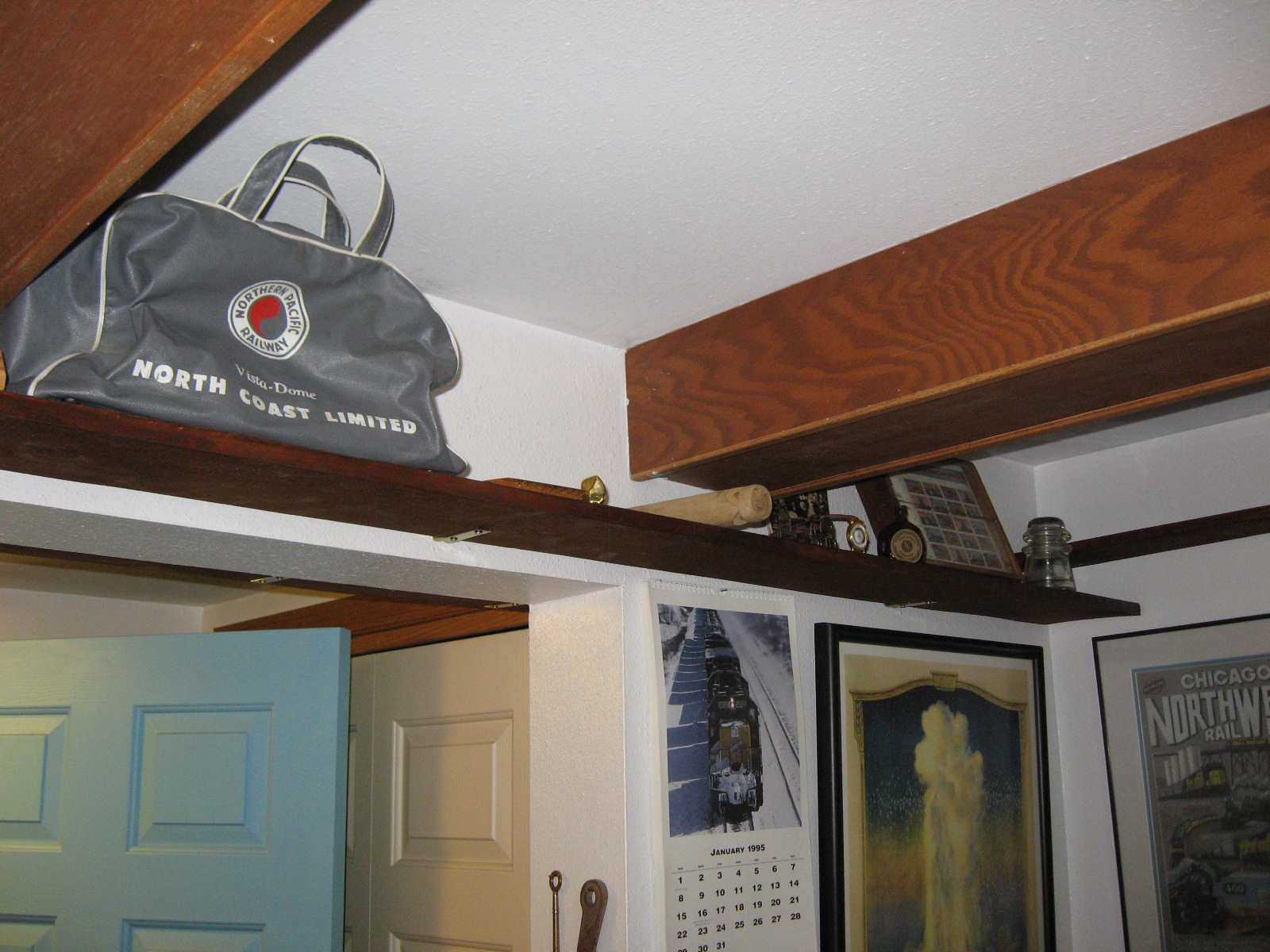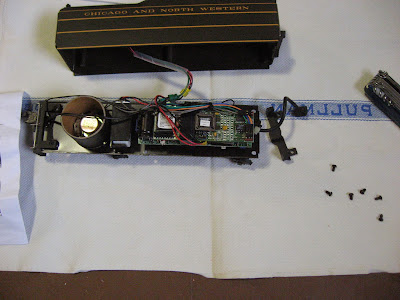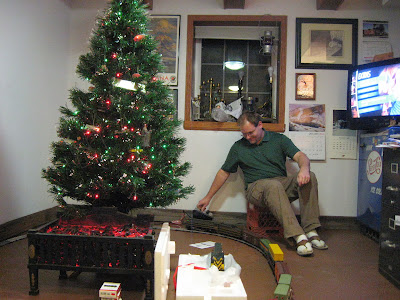Welcome back for more ferroequinological fun! No advancements
were made this week in the Train Room per se, but great progress was made in
the downstairs hall. Once the southern part of the downstairs hall is complete,
the majority of the hallway items in the Train Room can move back to their
rightful place, and then work can progress in the Train Room again. In the hall,
I painted the ceiling white, and painted the walls brown (using more free paint
from the Restore!) I also place boxcar wood baseboards along the southern walls
and into the stairway. My wife helped us come up with some really nifty decor
ideas for the north wall of the hallway - it will take a bit, but it will look really
cool. (Of course, pictures will come when completed.) While working on the
hallway, I got to watch/listen to some really neat steam locomotive DVDs playing
from the Train Room. Also this week, arrangements for the visiting HO train
collection were finalized - I'll have more on that in the next update, but I
think it is a great scenario that will help promote the fun of model
railroading to a new generation!
So, this week I'll talk about 6 new additions to the O-Scale
fleet in January 2014. These were all purchased through on-line auctions via
eBay or Trainz.
American View
For some time, I've been looking for an O-Scale Union Pacific
vista dome passenger car from the City of Los Angeles passenger train. Now, why
would such a pro-C&NW anti-UP fellow like me want to do that? Well, in
1956, my mother and my uncle took a trip with my grandfather on the City of Los
Angeles from California to Illinois. My Mom recalled the fun she had on the
train, especially in the vista dome car. My Mom has been very encouraging to my
railroading hobby, and her help was a great boon to the first scenic'd train
set I developed in Illinois. (She was the Scenery Engineer of the SDCR&GC
RR.) She also enjoys the wonders of the rails, although probably not to the
same extent as me! My uncle is a fellow O-Scale model railroader, gifting my first
Lionel train when I was 3, nominating me to join the TCA later on, and continually
inspiring me with the massive layout he built in Illinois. (My father has always,
and continues to enjoy the railroading hobby as well - he just wasn't on the
City of Los Angeles, so I'll have to find something else to commemorate him with
in a future entry!) ANYway... this model is a fancy aluminum 20" car made
by Weaver Models. It is in like-new condition, but is boxless. Now in
real-life, American View was never part of the City of Los Angeles. Actually,
it never was a vista dome either. It was actually a sleeper car on the Union
Pacific Butte Special, which ran between Denver, CO and Butte, MT (pictured at the top of today's blog entry.) So, this car
also gets to commemorate the home city of our friends Darren and Patti: Butte,
MT. Darren enjoys railroading as well, and we've even gone on a ferroequinological-archeological
adventure in Forsyth, MT, but that is a tale for another time... Anyway, back to
the American View - I also acquired it because it has a nifty patriotic name,
and although I am not a fan of the UP, I really look forward to running this
car on the layout. Since it is a bit of a conglomeration, the car could
technically be based out of Chicago, Denver, Butte, AND Los Angeles, which
opens up a variety of fun match-ups. It would be right at home amongst the
C&NW passenger cars on The Challenger, since that train was a joint
operation between the C&NW and UP. It would also work on the NP North Coast
Vista Dome Limited, which connected with Butte. It would be a fun guest on the
RI Rocky Mountain Rocket too, which connected Chicago and Denver. So, lots of
fun is ahead for the American View, not just because of new opportunities, but
also because of the journey it memorializes. On another happy note, a real-life
"American View" car still survives today. There are some conflicting reports
as to it's original heritage, but there is an "American View" dining
car on display at the museum in little ole' Mendota, IL.
Another new addition this month is a boxless Dubuque Packing
Company reefer made by Canadian Model Trains (CMT). This is the only CMT car in
the collection thus far. This past Fall, my sister got married and now lives in
Dubuque, IA. There are not many O-Scale cars dealing with Iowa, let alone
Dubuque! Another neat connection is that my sister's husband works for a meat processing/preparation
company, so this car has some fun meaning to me!
The rest of the entries are great new members of the fleet,
but most likely lack the commemorative-ness of the first two! Next is a sleekly
painted boxless Weaver Models Great Northern storage mail express car. This car
will proudly ride behind the head-end of the yet-to-be acquired Empire Builder
passenger train. Also joining the collection is an MTH/Railking Milwaukee Road
gondola. This is from MTH's early days, when the Railking logo was purple with
yellow accents. Although Railking is not necessarily O-Scale, I've found from
experience that this particular gondola is (or really really close).A red O-Scale
Texaco two-dome tank car from K-line joined the roster, and a smaller K-line
single-dome Milwaukee Road tank joined as well. I'm not quite sure about the
scale-ness of this one, but the detailing looks very good, and I recently
acquired another O-Scale tank car that was smaller, but authentic. Tank cars
seem to have been built in a range of sizes in real-life, so I'm hoping this
one fits right in on the O-Scale layout of the future!
Until next time, enjoy the food, commercials, and football
on Sunday (but mostly the food), and keep your rails shiny ~
 |
| UP "American View" Vista Dome |
 |
| Great Northern storage mail express car |
 |
| Dubuque Packing Company reefer |
 |
| Milwaukee Road tank car, Texaco tank car, and Milwaukee Road gondola |




























